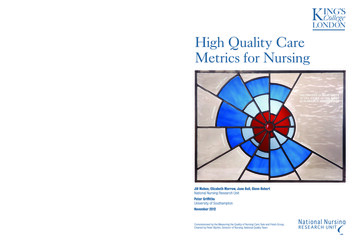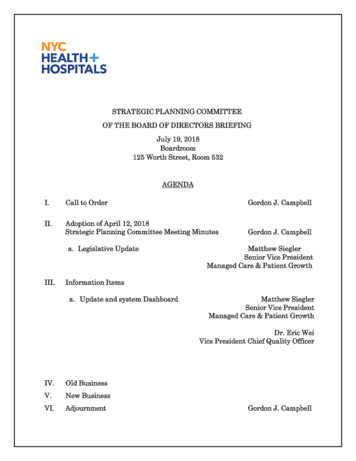
Transcription
High Quality CareMetrics for NursingThis is an independent report by the National Nursing Research Unit (NNRU) atthe Florence Nightingale School of Nursing and Midwifery, King’s College London incollaboration with the University of Southampton. The NNRU receives funding from theDepartment of Health through the Policy Research Programme.This report has been commissioned by the Measuring the Quality of Nursing Care Taskand Finish Group, chaired by Peter Blythin, Director of Nursing, National Quality Team.The views expressed here are not necessarily those of the Department.Contact address for further information:National Nursing Research UnitFlorence Nightingale School of Nursing and MidwiferyKing’s College LondonJames Clerk Maxwell Building57 Waterloo RoadLondon SE1 8WAEmail: nnru@kcl.ac.ukNNRU website: spxFlorence Nightingale School of Nursing and Midwifery website: http://www.kcl.ac.uk/nursing/index.aspxThis report should be cited as:Maben, J., Morrow, E., Ball, J., Robert, G., and Griffiths, P. High Quality Care Metricsfor Nursing. National Nursing Research Unit, King’s College London, 2012.Jill Maben, Elizabeth Morrow, Jane Ball, Glenn RobertNational Nursing Research UnitPeter GriffithsUniversity of SouthamptonNovember 2012Commissioned by the Measuring the Quality of Nursing Care Task and Finish Group,Chaired by Peter Blythin, Director of Nursing, National Quality Team
High quality care metrics for nursingThis is an independent report by the National Nursing Research Unit (NNRU)at the Florence Nightingale School of Nursing and Midwifery, King’s CollegeLondon in collaboration with the University of Southampton. The NNRUreceives funding from the Department of Health through the Policy ResearchProgramme.This report has been commissioned by the Measuring the Quality of NursingCare Task and Finish Group, chaired by Peter Blythin, Director of Nursing,National Quality Team. The views expressed here are not necessarily those of theDepartment.Contact address for further information:National Nursing Research UnitFlorence Nightingale School of Nursing and MidwiferyKing’s College LondonJames Clerk Maxwell Building57 Waterloo RoadLondon SE1 8WAEmail: nnru@kcl.ac.ukNNRU website: spxFlorence Nightingale School of Nursing and Midwifery website: http://www.kcl.ac.uk/nursing/index.aspxThis report should be cited as:Maben, J., Morrow, E., Ball, J., Robert, G., and Griffiths, P. High Quality CareMetrics for Nursing. National Nursing Research Unit, King’s College London,2012.Cover artwork: Interpretation of the ‘Diagram of the Causes of Mortality inthe Army in the East’ by Florence Nightingale. Created to celebrate the 35thAnniversary of the National Nursing Research Unit at the Florence NightingaleSchool of Nursing & Midwifery, King’s College London on 11th September2012. Photograph of stained glass panel by Angi Driver.
High quality care metrics for nursingForewordEvery nurse knows that patients have different needs from one another. They alsoknow that the safety and quality of the care they give can make all the difference topatients and their families. Nurses draw on their knowledge and skills, but they alsouse experience, intuition and creativity to meet those needs. Whilst nurses need tobelieve in their own practice, they also need to know that they are delivering carecompetently in a way that matters most to those they care for. The effects of careneed to be captured through measurement.At a time when cases of poor quality care and lack of compassion have becomethe focus of media attention, now more than ever, nurses and their leaders need toadvance the way they use measurement to best effect. Measuring the quality of careis central to providing an NHS that is more transparent, accountable and focused onimprovement.In practical terms, measurement can help to minimise the risk of a patient gettingpressure ulcers or suffering a fall, it can help to reduce the chance of spreadinghealthcare associated infections, or help a patient to recover more quickly.Measurement can also help inform patients about their own progress, and provide thewider public with information about the impact of nursing care.Whilst there has been considerable interest and some notable successes insystematically measuring the quality of care in the UK, further work is needed toconsolidate and build on this. That is why I asked Peter Blythin to chair a Taskand Finish group to consider how we measure the quality of nursing care in theNHS. This report supported the group’s work by setting out current knowledge andexperience on nursing metrics and identifying the key issues in developing metrics forthe future.This report draws together information about a wide-range of UK initiatives andinternational developments in the measurement of nursing quality and describes: current knowledge and issues about use of nursing metrics types of nursing metrics that are currently being used in the English NHS national and international trends in measurement of nursing the feasibility of a national set of key indicators of high quality nursing design and implementation of an infrastructure that enables national consistencyand benchmarking between organisationsCare quality metrics, if developed and used in the right way, have the potentialto support and improve nursing in all areas of care delivered through the NationalHealth Service in England. So that nurses, wherever they work, do not just believein what they are doing, but can know that they have made a positive difference tothe patients. This report is another important step in enabling this process.Jane CummingsChief Nursing Officer for England
High quality care metrics for nursing
High quality care metrics for nursingContentsSummary11.Introduction42.Aim43.What is needed53.1Establish a set of clearly defined key indicators of high quality nursing63.2Consider key indicators of high quality nursing alongside broaderfactors that underpin high quality healthcare73.3Align nursing metrics with ‘what matters most’ to patients83.4Demonstrate the broader contribution of nursing to high quality care93.5Design and implement infrastructure that enables national consistency114.Developments in nursing metrics124.1International systems using nursing metrics124.2Metrics for quality improvement and transparency in the UK154.3Specialty-specific metrics164.4Metrics in NHS accountability systems175.Principles for success215.1Fit for purpose (transparency, accountability, improvement)215.2Align with clinical outcomes and quality initiatives215.3Evidence-based225.4Clear, consistent and collectable (drawn from data that isroutinely collected)225.5Embedded in quality standards236.Conclusions24References26Appendix: The Task and Finish Group members32ANNEX 1: Nursing quality initiatives (United Kingdom)33ANNEX 2: Nursing quality initiatives (International)53
High quality care metrics for nursingSummaryIn April 2012 the Chief Nursing Officer Designate, Jane Cummings, requestedthe establishment of a Task and Finish Group to look at measuring the quality ofnursing care in the National Health Service (NHS). To inform the work of theGroup the National Nursing Research Unit (NNRU) at King’s College Londonwas asked to undertake a rapid appraisal (June-July 2012) of the evidence to dateon nursing measures.The overall purpose of the resulting High Quality Care Metrics for Nursingreport is to bring together the evidence and theory in a useful way to informrecommendations that will be put forward by the Task and Finish Group. Inparticular it aims to: Review current knowledge and issues in defining and using nursing metricsas part of a national architecture for measuring the quality of healthcare thatenables: accountability, quality improvement and transparency (the threedimensions identified in the NHS Outcomes Framework). Build on the 2008 National Nursing Research Unit report State of the ArtMetrics (Griffiths et al. 2008) to further identify the nursing metrics that arecurrently in operation, and explore any major trends, both nationally andinternationally.The wider context of this work is a need to: Establish a (small) set of clearly defined key indicators of high quality nursing. Consider these alongside broader factors that underpin high quality healthcare. Align nursing metrics with ‘what matters most’ to patients in terms of theirexperiences. Demonstrate the broader contribution of nursing to high quality care. Design and implement an infrastructure that enables national consistency andbenchmarking between organisations.This report looks at UK initiatives and international developments in themeasurement of nursing quality. Advances since our 2008 report include: moreinternational healthcare systems using nursing metrics, the development of metricsfor quality improvement and transparency in the UK, specialty-specific metrics(e.g. mental health nursing) and metrics in NHS accountability systems (e.g.clinical dashboards).1
High quality care metrics for nursingKey findings of this report are that: There are a number of widely recognised indicators of nursing care quality.These include:·Healthcare associated infection·Pressure ulcers·Falls·Drug administration errors·Patient complaints It is unclear the extent to which all of these are sensitive to variation in nursingquality but they are plausible and, as such, widely supported. There are numerous contextual variables that impact upon the quality ofnursing care which can be regarded as wider structural indicators. Theseinclude:·Workforce e.g. staffing levels, skill mix, sickness absence·Staff experiences e.g. perception of the practice environment·Systems e.g. admissions, discharge, handover Many NHS trusts are measuring some or all of these indicators in a structuredway at a local level, including the use of quality dashboards. There is considerable overlap between approaches to quality measurement butlittle standardisation of indicators. As a result, many current systems of measurement do not permit benchmarkingbetween organisations at the ward/unit level. There is some degree of standardisation around specific nursing qualityindicators for patient safety, including measures for falls and pressure sores(the NHS Safety Thermometer, and through the North West Transparencyproject). We do not have good risk adjustment for measures such as falls and pressureulcers to ensure valid comparisons between organisations. Few if any UK systems appear to have the sophistication of the ‘state of the art’represented by the United States and Canadian systems, although we have notbeen able to review them in depth here.2
High quality care metrics for nursingLessons from international systems are that: Systems that collect patient level data can be risk adjusted, to ensuremeaningful comparison across the system (i.e. benchmarking between matchedcomparators, or for specific specialties). Systems and infrastructure need to be put in place and tested to enableconsistent definition, collection and interpretation of information. Commitment and investment is needed to develop and secure the requiredinfrastructure It is essential to have sufficient resourcing including for example the rightinformatics systems, information technology and expertise in place. Professional learning networks specifically focusing on the contribution ofnursing to achieving high quality care can support implementation.Whilst there has been considerable interest and some notable successes inmeasuring nursing quality in the UK, further work is needed to: Coordinate a consistent and standardised approach to the collection, analysis,and interpretation of a core minimum dataset. Identify a wider range of metrics and indicators that relate to effective andcompassionate care, not just safety. Develop metrics and systems that reflect the wider structural factors thatunderpin nursing quality, such as staffing, skill mix and staff experiences andlink to other care quality metrics such as patient experience. Create or adapt local infrastructure (e.g. information systems and technologies)to minimise the burden of measurement on staff. Gain an informed understanding of what aspects of nursing quality are beingmeasured by any new system, and what is not - or cannot - be measured (but isstill important) and how this fits with the ‘whole picture’ of nursing quality. Explore the potential for patient level data to be risk adjusted, to ensuremeaningful comparison across the system (i.e. benchmarking between matchedcomparators, or for specific specialties). Develop and secure support from national and regional leads for a nationalsystem of measurement and reporting before rolling-out any futuremeasurement initiative to healthcare provider organisations. Support professional learning networks which focus on the contribution ofnursing to achieving high quality care.3
High quality care metrics for nursing1. IntroductionIn April 2012 the Chief Nursing Officer Designate, Jane Cummings, requestedthe establishment of a Task and Finish Group1 to look at measuring the qualityof nursing care in the National Health System (NHS). There is increasing needfor the nursing profession to demonstrate its considerable impact in an open,transparent and clearly understood way.The Task and Finish Group, chaired by Peter Blythin, Director of Nursing,National Quality Team, and with Project leadership from Michelle Mello,National Lead Energise for Excellence, had a twelve week reporting time, witha final report due by the end of July 2012. The group agreed underpinningprinciples were that measures need to be relevant, clear and build on what isalready there (notably, Energise for Excellence and the NHS Change Model).The Group also felt strongly that measures need to focus on values and outcomesthat are important to patients, carers and their families and that staff engagementis essential.To inform the work of the Group the National Nursing Research Unit (NNRU) atKing’s College London were asked to undertake an appraisal of the evidence to dateon nursing measures. The overall purpose of High Quality Care Metrics for Nursing isto bring together the evidence and issues in a useful way to inform recommendationsthat will be put forward by the Task and Finish Group. This rapid appraisal of theliterature was undertaken over a six week period in June-July 2012.2. AimThe aim of this report is to bring together the evidence and theory to informrecommendations that will be put forward by the Task and Finish Group onmeasuring nursing quality in the English National Health Service to provide aclear steer for national development of nursing measurement.In particular it aims to: Review current knowledge and issues in defining and using nursing metricsas part of a national architecture for measuring the quality of healthcare thatenables: accountability, quality improvement and transparency (the threedimensions identified in the NHS Outcomes Framework). Build on the 2008 National Nursing Research Unit report State of the ArtMetrics (Griffiths et al. 2008) to further identify the nursing metrics that arecurrently in operation, and explore any major trends, both nationally andinternationally.1Membership of the group is presented in the Appendix.4
High quality care metrics for nursing3. What is neededThis section draws on other more generic work on measurement in healthcare andbuilds on the findings of State of the Art Metrics to outline what is needed. Figure 1brings these perspectives together in a broader conceptual framework.Figure 1: Conceptual modelWhatisimportant?Whatmatterstop atients? Feelinginformedandbeinggivenoptions Staffwholistenandspendtimewithpatient Beingtreatedasaperson,notanumber Patientinvolvementincareandbeingabletoaskquestions Thevalueofsupportservices sstheNHS? Preventingpeoplefromdyingprematurely Enhancingqualityoflifeforpeoplewithlong- ‐termconditions lowinginjury Ensuringthatpeoplehaveapositiveexperienceofcare ctable)Whatmatterstostaff? Theresourcestodeliverqualitycareforpatients ThesupportIneedtodoagoodjob Aworthwhilejobwiththechancetodevelop eporting5
High quality care metrics for nursing3.1 Establish a set of clearly defined key indicators of high quality nursingThe first driver is a need to generate evidence about the quality of nursing – firstand foremost to assure standards are met and accountability structures are inplace (Mooney 2009; Sunderland 2009). This requires well-defined indicators ofnursing quality that are clear and can be consistently used to understand nursingquality. High Care Quality for All (DH 2008) offered a tripartite definition ofquality - patient safety, patient experience and effectiveness of care. Measurescould help to capture information on many aspects of quality, including: safety,effectiveness and patient experience (Blegen 2006, Foulkes 1987). Whilstin principle most nurses would agree they want to deliver safe, effective andcompassionate care, it is harder to measure some aspects of quality than others(Bailey 2008).Nevertheless the arguments for developing a set of generic indicators for nursingquality are strong. Most focus for nursing metrics to date has been on developingnursing minimal datasets with defined outcome measures and indicators. Thenursing datasets that have been developed and applied in some countries havemany features in common, but there are differences in purpose, content, sampling,collection approach, and developmental stage as well (Goossen et al. 1988).What can be measured broadly falls into three categories: process, structure,outcomes (Donabedian 1988). However the nature of relationship is dynamic.Some process measures are adopted simply because of ease of measurementwithout real consideration of their validated relationship with outcomes (Griffithset al. 2008).Metrics that are most likely to be sensitive to differences in nursing input(e.g. healthcare associated infection, pressure ulcers, falls) are potentially goodindicators of safety (Griffiths et al. 2008; Doran 2011) but risk adjustment toaccount for differences in underlying risk remains problematic. There are anumber of associations between the failure to rescue indicators and presumedmarkers of quality, however it is not clear whether failure to rescue is a specificallynurse sensitive indicator and this requires further research (Jones et al. 2011).Staff experience is a further potential area for drawing evidence about nursingquality. Recent research on staff wellbeing has established a link between staffmotivation, affect and wellbeing and patient experiences of care (Maben etal. 2012). Staffing and skill mix are known to be linked to patient outcomes inacute and community care (Bostick et al. 2006), but applying these genericallycould create perverse incentives. Actual staffing rate relative to planned staffingis a potentially useful indicator to include. However there are also limitationsto applying measures to different services, settings and patient groups. Thearguments centre on the issue that nursing cannot be meaningfully evaluated6
High quality care metrics for nursingwithout considering the healthcare contexts that it is embedded within. Evenwhere consistent measures can be applied there can be limitations to comparabilitydue to geographical and demographic variations across the healthcare system andbetween service settings (Raleigh and Foot 2010). Measures, especially measures ofoutcome, generally need to be risk adjusted to enable comparison across settings.Related to this issue is a question about the type of local improvementinformation that more specifically applies to different services, settings and patientgroups. Extensive amounts of data are already collected in service setting. Thesecan be used where possible, but there is a need to identify how data collectionsystems could be adapted to enable consistent data collection and increaseindicator validity.3.2 Consider key indicators of high quality nursing alongside broader factors thatunderpin high quality healthcareKey indicators of nursing quality alone will not provide the whole picture onnursing quality (Doran 2003). There also needs to be data about the factors thatunderpin quality, including for example: Staffing levels: supernumerary staff, bank/agency staff, staff/patient ratios Skill mix: staff experience/knowledge/skills & expertise Sickness rates Vacancy rate/staff turnover Appraisal/induction Record of Continuous Professional Development/learning planThere is also a need for information that reflects the quality of the workplaceand the systems, leadership, teamwork and professional development in place tosustain quality (Laschinger and Leiter 2006). Research suggests that what mattersto staff (IPSOS MORI 2008) is having: the resources to deliver quality care forpatients, manager and colleague support, a worthwhile job with the chance todevelop, the opportunity to make improvements to the way the team works.Key indicators of staff experience are: Staff satisfaction and wellbeing Practice environment/perceived quality Perception of adequate staffing Interprofessional relations Staff intention to leave7
High quality care metrics for nursing3.3 Align nursing metrics with ‘what matters most’ to patientsEnsuring that people have a positive experience of care is a key domain of theOutcomes Framework and England led the world in commissioning a nationalsurvey of patients’ experiences in 2001. The national survey data is valuable formonitoring purposes because it is based on randomly selected, representativepopulations; the questions are standardised; and it is possible to compare hospitalsand track trends over time (Robert et al. 2012). However, at ward and servicelevel there is evidence that clinical teams and middle management make little useof national patient survey data to monitor service quality and drive local qualityimprovement (Robert & Cornwell 2012).Recent recommendations to the Department of Health on what matters topatients (Robert and Cornwell 2012) were based on research that identified sixgeneric factors that patients want from their care (see ‘What matters to patients?’[Robert et al. 2012] in Figure 1 above). In 2012, the Department of Health,through its National Quality Board, subsequently adopted a modified version ofthe Picker Institute Principles of Patient-Centred Care framework to provide acommon evidence-based list of what matters to patients that can be better usedto direct efforts to improve services. For example, it can be used to help definewhat questions to ask patients in surveys and in real time feedback. Other currentnational developments include the development and testing of an NHS-widesingle indicator of patient experience - the Net Promoter Score (NPS), morecommonly known as ‘the friends and family test’. The standard Net Promoterquestion is ‘How likely is it that you would recommend our service to a friend orcolleague?’ and respondents indicate this likelihood on a 10-point rating scale.Further work is being undertaken to validate the choice of wording and scales forcollecting data across the NHS (Graham and MacCormick 2012).Whilst there is substantial literature on the use of clinical indicators andnursing metrics, there is less evidence relating to indicators that reflect importantaspects of the patient experience beyond the functional and transactional aspectsof their care. Public and professional concerns about loss of compassion andexpressions of caring (Montalvo 2007) (relational aspects of care) may not easilybe addressed by measures that only focus on clinical processes and outcomes. It istherefore important to more closely link nursing quality measurement to patientexperiences of care, including for example, patients’ experiences of: dignity,respect, information about treatment/medicines, comfort and cleanliness of wardenvironment, staff attitude and communication, involvement in decision-makingand care planning (Bergh et al. 2011). In response to this need for better ways ofcapturing and understanding patient experiences of the relational aspects of theircare, the ‘Patient Experience of Emotional Care in Hospital’ (PEECH) instrumentwas developed by Anne Williams and Linda Kristjanson (2009) in Australia using8
High quality care metrics for nursingGrounded Theory methods. Recent validation of the PEECH instrument in theUK (Maben et al. 2012) suggests that it can help to build understanding of themore complex interpersonal aspects of quality including compassion, empathy andresponsiveness to personal needs, alongside transactional and functional aspects ofcare that are captured in the existing national patient survey programme.Similarly, research by McCance et al. (2012) using a nominal group techniquewith nursing staff working at all grades in two health and social care trusts inNorthern Ireland (n 50) and a regional consensus conference (n 80) identifiedeight top-ranked indicators as a core set for nursing and midwifery. The relevanceand appropriateness of these indicators were confirmed with nurses and midwivesworking in a range of settings and from the perspective of service users. Whilstsome of these indicators are addressed in the current National Patient ExperienceSurvey, it does not always ask specifically about nursing and, as described elsewhere(Robert & Cornwell 2012), results cannot easily be attributed to the specific settingsof nursing care delivery (e.g. wards or units) where the information was collected.3.4 Demonstrate the broader contribution of nursing to high quality careAt the same time there is widespread recognition that nurses do not work inisolation and there is a need to generate transparent evidence of how nursingcontributes to high quality care (Ham 2009) and health service performance(Aiken et al. 2012). The multitude of existing quality frameworks within theNHS makes it imperative to align nursing measurement with what is important,avoid duplication, and minimise the burden on staff. For example, The NHSConstitution provides an overall framework for NHS services based on pledges andrights; National Service Frameworks and strategies set clear quality requirementsfor care. NICE (National Institute for Health and Clinical Excellence) Guidanceand Quality Standards set out markers of high-quality, cost-effective patientcare, covering the treatment and prevention of different diseases and conditions.There are also governance and incentive frameworks such as Monitor’s QualityGovernance Framework for NHS foundation trusts; the Quality OutcomesFramework (QOF) for all general practice surgeries in England; and the CQUIN(Commissioning for Quality and Innovation) payment framework which sets outdifferent goals for providers in different regions.The NHS Outcomes Framework 2012/2013 has been designed as an overallframework for defining how the NHS will be accountable for outcomes. It setsout five domains, articulating the responsibilities of the NHS and 12 overarchingindicators covering the broad aims of each domain. The five domains are: Domain 1: Preventing people from dying prematurely Domain 2: Enhancing quality of life for people with long-term conditions9
High quality care metrics for nursing Domain 3: Helping people to recover from episodes of ill health or followinginjury Domain 4: Ensuring that people have a positive experience of care Domain 5: Treating and caring for people in a safe environment and protectingthem from avoidable harmNurses would expect to contribute to all five domains including public health andhealth promotion activities in domain 1; and significant aspects of care delivery toenhance and support quality of life and recovery in domains 2 and 3. Figure 2 asan example, illustrates how across these domains indicators of nursing quality canbe directly related to: Domain 4: Ensuring that people have a positive experienceof care, and Domain 5: Treating and caring for people in a safe environment andprotecting them from avoidable harm.Figure 2: Alignment with the Outcomes FrameworkTRANSPARENCYTo provide a national leveloverview of how well the NHS(nursing) is performing,wherever possible in aninternational dinfectionFallsPressure soresDomainDomain 5:Treating andcaring for peoplein a safeenvironment andprotecting themfrom avoidableharmACCOUNTABILITYQUALITYIMPROVEMENTTo provide an accountabilitymechanism between theSecretary of State for Healthand the proposed NHSCommissioning BoardTo act as a catalyst for driving qualityimprovement and outcome measurementthroughout the NHS by encouraging achange in culture and behaviour,including a stronger focus on tacklinghealth
This is an independent report by the National Nursing Research Unit (NNRU) at the Florence Nightingale School of Nursing and Midwifery, King's College London in collaboration with the University of Southampton. The NNRU receives funding from the Department of Health through the Policy Research Programme.











